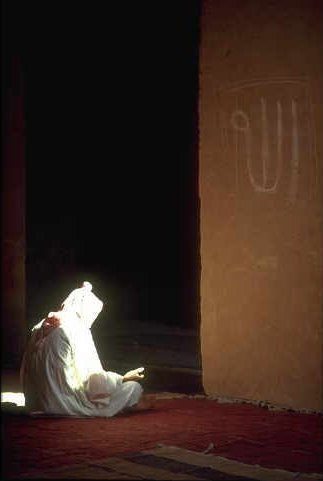Islamic
Mysticism (Religion 337)
Omid
Safi
Colgate
Universsity
| |
 |
Sufism:
Path to God,
through the Heart

"Love is a flame.
It burns away all
that is not God."
|
|
 |
 |
|
Islamic
Mysticism (Religion 337)
Colgate
University
Omid Safi: osafi@mail.colgate.edu
(315)
228-7690
Catalogue
Description
This course seeks to
engage the mystical interpretations of Islam (Sufism) as
simultaneously one of the most important historical
manifestations of the Islamic experience and one of the
most pertinent ones for understanding Islam in the
contemporary situation. Themes explored in this class
include the tradition of love mysticism embodied by Rumi,
the metaphysical formulations of Ibn al-Arabi, the
formation of Sufi orders, the various meditative
techniques, and Sufi poetry and music. The class also
explores the controversies surrounding Sufism in the
contemporary scene ranging from attacks on Sufism from
Muslim fundamentalists to the role of Sufism in the
spread of Islam in Europe and North America.
Grade to be
based on:
- Daily assignment (Talking Points) plus
active, in-class discussion: 40 %
- Bring a focused "talking
point" (between 2-3 pages) to every class. A talking
point is a form of dialogue between you and the readings:
that is to say, reflections and queries you are prepared
to share with a classmate and/or with the instructor.
Your daily "talking points" will play a
considerable role in shaping the day's discussion. Every
talking point must contain 2-3 written questions
to be asked in class.
- I leave it up to you to decide how you
will engage the text in your talking point:
*reflect on an idea you found interesting or
intriguing in the assigned readings,
*explore the implications of a particular idea,
* discuss how the various readings complement or differ
from each other,
*compare to another work we've studied,
*trace how the work speaks to a theme we encountered
earlier.
- Two five page reports 30 %
- Final research paper (15-20 pages): 30
%
Important
Dates to keep in mind:
January 25th, 2000 6 P.M. Dinner
at Omid’s home, 64 Lebanon St.
February 5th, 2000 7 p.m. Sufi Music Concert, at the
Commons
February 28th, 2000 5 p.m. Assignment #1 due.
March 6th, 2000 in-class Topics for final research
paper due.
March 22nd, 2000 5 p.m. Assignment #2 due.
April 3rd, 2000 5 p.m. Annotated bibliography due.
April 26th, 2000 5 p.m. 3-page synopsis of the final
research paper.
May 8-12 Final paper due at time of final exam.
Assigned sources:
Books:
Required for the class, bring
the readings with you to each class.
Martin Lings, Sufi
Saint of 20th Century
Michael Sells, Early
Islamic Mysticism
Annemarie Schimmel, Mystical
Dimensions of Islam
Annemarie Schimmel, Triumphal
Sun
S. Hirtenstein, Unlimited
Mercifier
Ruzbihan Baqli, Unveiling
of Secrets
Shams Friedlander, Whirling
Dervishes
CD: Oruj Guvenc, Oceans
of Remembrance.
Web resources:
You would do well to
acquaint yourselves with the following web-page,
and use it as a frequent
point of entry and exploration around many of the issues we will
be discussing:
http://www.arches.uga.edu/~godlas/sufism1.html
The Course-PAC
[CP]
The CP is to be purchased
in the class. This is to save you the hefty cost of an
official "Course-Pac."
- Javad Nurbakhsh, "The Key
Features of Sufism in the Early Islamic Period", Classical
Persian Sufism: From its Origins to Rumi, p.
xv-xxxix., [handed-out first day of class]
- Seyyed Hossein Nasr, "The Sufi
Master as Exemplified in Persian Sufi Literature", Sufi
Essays, pp. 57-67.
- H. Landolt, "Walyah", The
Encyclopedia of Religion, pp. 316-323.
- F. Samuel Brainard, "Defining
'Mystical Experience", JAAR 1996(1): 359-388.
- Al-Kalabadhi, "How the Sufis
Account for their being called Sufis", The
Doctrine of the Sufis, Translated by A. J. Arberry,
pp. 5-11.
- R. A. Nicholson, "Origin and
Development of Sufism", Journal of Royal Asiatic
Society (1906): 330-348.
- Carl Ernst, "What is Sufism? The
Orientalist Discovery of Sufism", Shambhala Guide
to Sufism, pp. 1-31.
- James Morris, "Situating Islamic
‘Mysticism’: Between Written Traditions and
Popular Spirituality", Mystics of the Book, Robert
A. Herrera, ed., 293-334.
- Nicholas Heer, "Abu Hamid
al-Ghazali’s Esoteric Exegesis of the Koran", Classical
Persian Sufism: From its Origins to Rumi, pp.
235-257.
- James Morris, "The Spiritual
Ascension: Ibn Arabi and the Mi’raj", J.A.O.S.
107(4): pp. 629-652.
- A. Schimmel, And Muhammad is His
Messenger, pp. 24-55, 123-143.
- Leonard Lewisohn, "In Quest of
Annihilation: Imaginalization and Mystical Death in the Tamhidat
of Ayn al-Qudat Hamadhani", Classical Persian
Sufism: From its Origins to Rumi, Lewisohn, ed.,
285-335.
- Junayd, "The Theory of
Fana’", and "Kitab al-Fana’", The
Life, Personality, and Writings of al-Junayd, pp.
81-87, 152-167.
- Jamal Elias, "Traveling the Sufi
Path", The Throne Carrier of God, pp.
101-118.
- Jamal Elias, "The Spiritual Body
and the Mirror of God", The Throne Carrier of God,
pp. 79-99.
- Muhammad Isa Waley,
"Contemplative Disciplines in Early Persian
Sufism", ", Classical Persian Sufism: From
its Origins to Rumi, pp. 497-549.
- Jamal Elias, "Seclusion and
Recollection", The Throne Carrier of God, pp.
119-146.
- Razi, "The Need for Zekr",
"The Method of Zekr", "The Transmission of
Zekr", "The Need for Seclusion", Path
of God’s bondsmen, translated by Hamid Algar,
pp. 268-285.
- Herbert Mason, "Hallaj and the
Baghdad School of Sufism", Classical Persian
Sufism: From its Origins to Rumi, Lewisohn, ed., pp.
65-83.
- J. Gross, "Authority and
Miraculous Behavior", The Legacy of Mediœval
Persian Sufism, Lewisohn, ed., pp. 159-171.
- J. Elias, "Female and Feminine in
Islamic Mysticism", The Muslim World LXXVIII,
pp. 209-224.
- M. Chodkiewicz, "The Seal of
Muhammadan Sainthood", Seal of the Saints:
Prophethood and Sainthood in the Doctrine of Ibn 'Arabi, pp.
128-146.
- Michael Sells, "Ibn Arabi’s
Garden Among the Flames: The Heart Receptive of Every
Form", Mystical Language of Unsaying, pp.
90-115.
- James Morris, "Listening for God:
Prayer and the Heart in the Futûhât",[available
through www.ibnarabisociety.org/morris.html
- Abu Najib Suhrawardi, A Sufi Rule
for Novices, trans. Menahem Milson, pp. 27-83.
- Jean During, "What is Sufi
Music?", The Legacy of Mediœval Persian
Sufism, Lewisohn, ed., pp. 277-87.
- Jean-Louis Michon, "Sacred Music
and Dance in Islam", Islamic Spirituality II:
Manifestations, S. H. Nasr, ed., pp. 469-506,
- Th. E Homerin, "Ibn Arabi in the
People's Assembly: Religion, Press, and Politics in
Sadat's Egypt", Middle East Journal 80:4
(Summer, 1986), 462-77.
- S. H. Nasr, "Islam and the
Encounter of Religions", Sufi Essays, pp. 123-152.
- Marcia K. Hermansen, "Hybrid
Identity Formations in Muslim America: The case of
American Sufi Movements", Muslim World (forthcoming).
- Gisela Webb, "Sufism in
America", in America's Alternative Religions, Tim
Miller, ed., pp. 249-259.

Click Here for Course Syllabus
To
return to Omid Safi's Main Page






![]()